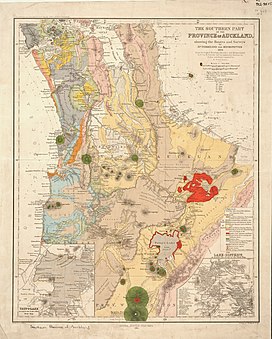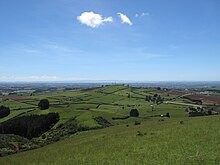| South Auckland volcanic field | |
|---|---|
 Hochstetter 1859 geological map of the southern part of the then Auckland Province that recognised the basalt (gray-purple) of the South Auckland volcanic field but few of its volcanic features. The map also shows what is now the Waikato, and identifies other volcanic features of this part of the North Island. Hochstetter 1859 geological map of the southern part of the then Auckland Province that recognised the basalt (gray-purple) of the South Auckland volcanic field but few of its volcanic features. The map also shows what is now the Waikato, and identifies other volcanic features of this part of the North Island. | |
| Highest point | |
| Elevation | 379 m (1,243 ft) |
| Coordinates | 37°11′44″S 175°01′05″E / 37.195506°S 175.018135°E / -37.195506; 175.018135 |
| Geography | |
| Location and extent of extinct South Auckland volcanic field | |
| Geology | |
| Rock age | Pleistocene (1.48–0.55 Ma) PreꞒ Ꞓ O S D C P T J K Pg N ↓ |
| Mountain type | Volcanic field |
| Rock type | Basalt |
| Last eruption | c. 550,000 years ago |
The South Auckland volcanic field, also known as the Franklin Volcanic Field, is an area of extinct monogenetic volcanoes around Pukekohe, the Franklin area and north-western Waikato, south of the Auckland volcanic field. The field contains at least 82 volcanoes, which erupted between 550,000 and 1,600,000 years ago.
Features
The field extends from Pukekiwiriki east of Papakura in the north and Pukekawa in the south. The field contains at least 82 volcanoes, and is older than the Auckland volcanic field to the north. The youngest volcanoes are likely the Bombay Hills shield volcano, which erupted an estimated 600,000 years ago, and Pukekohe Hill, the largest shield volcano of the field, which erupted an estimated 550,000 years ago. The largest tuff ring in the field is Onewhero maar which is 2.7 km (1.7 mi) in diameter and was formed 880,000 years ago. The field can be divided into three broad geographic areas: the north-eastern section, which consists of eroded remnants of lava flows and scoria cones, some of which are found in the south-western Hunua Ranges, the southern section to the south of the Waikato River, which features many of the more recent and better preserved scoria cones, and the central section, which forms much of the low-lying land of the Pukekohe area, between the Manukau Harbour and Waikato River.
Context
Relations to other volcanic activity
Other basaltic volcanic fields that are also now thought to represent intraplate volcanism active in the Pleistocene are adjacent from the south in a more recent to the north trend. As already mentioned the younger Auckland volcanic field is to its immediate north. To the south west is the older Ngatutura volcanic field which was active between 1,830,000 and 1,540,000 years ago and these locations fit with the south north trend being related to the opening of the Hauraki Rift in the Miocene or fracturing of the lithosphere. Further south is the Alexandra Volcanic Group. To its west, are the even older volcanoes associated with the Northland-Mohakatino volcanic belt (Mohakatino Volcanic Arc) which are of a subduction-related origin but which include the still active Mount Taranaki at the southern end of this belt. To the south and east, visible on the horizon from the Bombay Hills are back arc volcanoes. These include the volcanoes of the Taupō Volcanic Zone to the south which have now been continuously active for over 2 million years. This was also the time that activity ceased in the extinct volcanoes of the Coromandel Peninsula in the Coromandel Volcanic Zone to the east.
Tectonics
Many of the volcanoes are related to known fault structures as shown on a map on this page. The Auckland region lies within the Australian Plate, about 400 kilometres (250 mi) west of its plate boundary with the Pacific Plate. The volcanoes are located south of the Auckland volcanic field which is also part of what has been termed the Auckland Volcanic Province. The structure of the Auckland regional faults and the resulting fault blocks is complex but like the volcanic field their locations can be postulated to be related to gravitational variations and where the Stokes Magnetic Anomaly passes through this section of the North Island.
A north south line of central volcanoes is orientated along the Drury Fault. These extend from Papakura through and beyound the Bombay Hills. While the western margin of the belt is defined by the north-south Wairoa North Fault the eastern margins have at least three east-west fault lines. The unnamed most northern of these was presumably followed by the basaltic extrusion that extended all the way to the Morley Road tuff rings. The volcanoes along the lines of the Waiuku Fault and to the south the Waikato Fault that is also followed by the mouth of the Waikato River suggest that there has been strong volcano-tectonic relationships during the fields historic eruption activity.
Identification
The volcanic nature of the Tuakau and Pukekohe areas was first identified by Ferdinand von Hochstetter in 1859, however the first volcanic cones only began to be identified in the mid-20th century.
List of volcanoes
Quaternary volcanoes in Auckland region. To show well the volcanoes in relation to fault lines you have to click on the map to enlarge and then zoom and pan. This also enables mouse over of the volcano and fault names. Definite active faults are shown in red. Well characterised inactive fault segments are in dark grey and other faults are shown in grey. A number of faults characterised by sea floor studies off the west coast of North Island are not shown. The type of volcanic eruption (some are composite) is indicated by basalt shield type eruption (black), scoria cone (red), or phreatomagmatic eruptions tuff ring (red-brown) and maar (purple). Volcanoes from both the Auckland volcanic field and South Auckland volcanic field are displayed. Miocene volcanoes are not shown. Map of selected volcanic features of the South Auckland volcanic field, allowing wider context. Clicking on the map enlarges it, and enables panning and mouseover of volcano name/wikilink and ages before present. The type of volcanic eruption (some are composite) is indicated by basalt shield type eruption (black), scoria cone (red), or phreatomagmatic eruptions tuff ring (red-brown) and maar (purple). Dark brown shows basalt lava and deposit fields. The key to the other volcanics that are shown with panning is basalt - brown, monogenetic basalts - dark brown, undifferentiated basalts of the Tangihua Complex in Northland Allochthon - light brown, arc basalts - deep orange brown, arc ring basalts -orange brown, dacite - purple, andesite - red, basaltic andesite`- light red), rhyolite - violet, ignimbrite (lighter shades of violet), and plutonic - gray.References
- ^ Bischoff, Alan; Barriera, Andrea; Begg, Mac; Nicola, Andrew; Colea, Jim; Sahoo, Tusar (2020). "Magmatic and Tectonic Interactions Revealed by Buried Volcanoes in Te Riu-a-Māui/Zealandia Sedimentary Basins". New Zealand Journal of Geology and Geophysics. 63: 378–401. doi:10.1080/00288306.2020.1773510. S2CID 221380777.
- ^ Hayward, Bruce W. (2017). Out of the Ocean, Into the Fire. Geoscience Society of New Zealand. pp. 207–211. ISBN 978-0-473-39596-4.
- ^ Nemeth, Karoly; Kereszturi, Gabor; Agustín-Flores, Javier; Briggs, Roger Michael (2012). "Field Guide Monogenetic volcanism of the South Auckland and Auckland Volcanic Fields". Retrieved 2 November 2022.
- ^ Hayward, Bruce W (2015). "Helvetia Volcano–A Newly Recognised Tuff Ring and Maar In The South Auckland Volcanic Field". Auckland GeoClub Magazine (12).
- ^ Briggs, R. M.; Itaya, T.; Lowe, D. J.; Keane, A. J. (1989). "Ages of the Pliocene-Pleistocene Alexandra and Ngatatura Volcanics, western North Island, New Zealand, and some geological implications". New Zealand Journal of Geology and Geophysics. 32 (4): 417–427. doi:10.1080/00288306.1989.10427549. hdl:10289/5260.
- Le Corvec, Nicolas; Bebbington, Mark S.; Lindsay, Jan M.; McGee, Lucy E. (2013). "Age, distance, and geochemical evolution within a monogenetic volcanic field: Analyzing patterns in the Auckland Volcanic Field eruption sequence". Geochemistry, Geophysics, Geosystems. 14 (9): 3648–3665. doi:10.1002/ggge.20223. S2CID 130368256.
- ^ Kenny, A; Lindsay, JM; Howe, TM (2012). "Post-Miocene faults in Auckland:insights from borehole and topographic analysis". New Zealand Journal of Geology and Geophysics. 55 (4): 323–343. doi:10.1080/00288306.2012.706618. S2CID 128945408.
- Stewart, John R. "GSNZ Conference 26 November 2015: Auckland's buried faults and their influence on its geology" (PDF). Retrieved 12 November 2022.
- "Kawaka". New Zealand Gazetteer. Land Information New Zealand. Retrieved 5 November 2022.
- ^ "Ararimu". New Zealand Gazetteer. Land Information New Zealand. Retrieved 5 November 2022.
- ^ "Pukeoware". New Zealand Gazetteer. Land Information New Zealand. Retrieved 5 November 2022.
- ^ "Drury". New Zealand Gazetteer. Land Information New Zealand. Retrieved 6 November 2022.
- ^ "Bombay". New Zealand Gazetteer. Land Information New Zealand. Retrieved 5 November 2022.
- ^ "Pōkeno". New Zealand Gazetteer. Land Information New Zealand. Retrieved 5 November 2022.
- ^ "Buckland". New Zealand Gazetteer. Land Information New Zealand. Retrieved 5 November 2022.
- ^ "Whangarata". New Zealand Gazetteer. Land Information New Zealand. Retrieved 5 November 2022.
- ^ "Mauku". New Zealand Gazetteer. Land Information New Zealand. Retrieved 5 November 2022.
- ^ "Elbow Hill". New Zealand Gazetteer. Land Information New Zealand. Retrieved 5 November 2022.
- "Kellyville". New Zealand Gazetteer. Land Information New Zealand. Retrieved 5 November 2022.
- "Hunua Falls". New Zealand Gazetteer. Land Information New Zealand. Retrieved 21 October 2022.
- ^ "Runciman". New Zealand Gazetteer. Land Information New Zealand. Retrieved 6 November 2022.
- ^ "Onewhero". New Zealand Gazetteer. Land Information New Zealand. Retrieved 5 November 2022.
- ^ "Mangatawhiri". New Zealand Gazetteer. Land Information New Zealand. Retrieved 5 November 2022.
- ^ "Pukekawa". New Zealand Gazetteer. Land Information New Zealand. Retrieved 21 October 2022.
- ^ "Pukekiwiriki". New Zealand Gazetteer. Land Information New Zealand. Retrieved 21 October 2022.
- "Onepoto". New Zealand Gazetteer. Land Information New Zealand. Retrieved 21 October 2022.
- "Onewhero". New Zealand Gazetteer. Land Information New Zealand. Retrieved 5 November 2022.
- ^ "Tauranganu". New Zealand Gazetteer. Land Information New Zealand. Retrieved 5 November 2022.
- ^ "Pinnacle Hill". New Zealand Gazetteer. Land Information New Zealand. Retrieved 5 November 2022.
- ^ "Mount William". New Zealand Gazetteer. Land Information New Zealand. Retrieved 21 October 2022.
- "Pukekohe Hill". New Zealand Gazetteer. Land Information New Zealand. Retrieved 21 October 2022.
- "Puketutu". New Zealand Gazetteer. Land Information New Zealand. Retrieved 21 October 2022.
- "Pukeotahinga". New Zealand Gazetteer. Land Information New Zealand. Retrieved 21 October 2022.
- ^ "Opuawhanga". New Zealand Gazetteer. Land Information New Zealand. Retrieved 5 November 2022.
- "Tikorangi Hill". New Zealand Gazetteer. Land Information New Zealand. Retrieved 21 October 2022.
- "Tuakau". New Zealand Gazetteer. Land Information New Zealand. Retrieved 5 November 2022.
- ^ "Waiuku". New Zealand Gazetteer. Land Information New Zealand. Retrieved 6 November 2022.
| Auckland | |
|---|---|
| Major areas | |
| Local board areas | |



